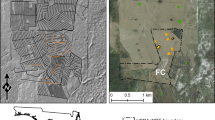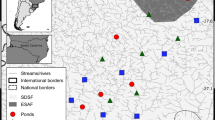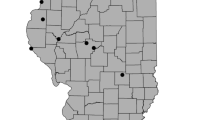Abstract
A primary goal of wetland restoration is to produce biologically diverse and resilient habitat, often to mitigate losses elsewhere. Many factors influence wetland biodiversity including hydrologic regime, soil chemistry, texture, and microtopographic variation. A better understanding of these relationships can provide valuable information to practitioners. This study sampled plant communities of eight created or restored Delmarva Bay wetlands a decade after project completion to identify drivers of plant diversity at multiple scales. Study wetlands varied in terms of size, hydroperiod, soil fertility, coarse woody debris application, and straw mulch type. Wetlands with shorter hydroperiods had higher herbaceous plant diversity, but both herbaceous and woody diversity declined as soil fertility increased. Coarse woody debris density was not related to any of the diversity variables measured. There was no difference in species richness, soil carbon, total N, C:N or exotic species cover between wetlands treated with wheat or barley straw. We found that alpha and beta diversity were significantly correlated with different independent variables in our study and were not intercorrelated, suggesting that beta diversity may be an additional tool to assess diversity in heterogeneous habitats like depression wetlands.




Similar content being viewed by others
References
Abrams MD (1998) The red maple paradox. Bioscience 48:355–364
Alsfeld AJ, Bowman JL, Deller-Jacobs A (2009) Effects of woody debris, microtopography, and organic matter amendments on the biotic community of constructed depressional wetlands. Biol Conserv 142:247–255
Angelov MN, Sung S-JS, Ron Lou D, Harms WR, Kormanik PP, Black CC Jr (1996) Long- and short-term flooding effects on survival and sink–source relationships of swamp-adapted tree species. Tree Physiol 16:477–484
Aronson MFJ, Galatowitsch S (2008) Long-term vegetation development of restored prairie pothole wetlands. Wetlands 28:883–895
ASTM (2007) Standard Test Method for Particle-Size Analysis of Soils: American Society for Testing and Materials
Athy ER, Keiffer CH, Stevens MH (2006) Effects of mulch on seedlings and soil on a closed landfill. Restor Ecol 14:233–241
Bailey DE, Perry JE, Lee Daniels W (2007) Vegetation dynamics in response to organic matter loading rates in a created freshwater wetland in southeastern Virginia. Wetlands 27:936–950
Ballantine K, Schneider R (2009) Fifty-five years of soil development in restored freshwater depressional wetlands. Ecol Appl 19:1467–1480
Ballantine K, Schneider R, Groffman P, Lehmann J (2012) Soil properties and vegetative development in four restored freshwater depressional wetlands. Soil Sci Soc Am J 76:1482–1495
Bedford BL, Walbridge MR, Aldous A (1999) Patterns in nutrient avability and plant diversity of temperate North American Wetlands. Ecology 80:2151–2169
Bennett SH, Nelson JB (1991) Distribution and Status of Carolina Bays in South Carolina. South Carolina Wildlife and Marine Resources Department. 88 p
Bishel-Machung L, Brooks RP, Yates SS, Hoover KL (1996) Soil properties of reference wetlands and wetland creation projects in Pennsylvania. Wetlands 16:532–541
Blossey B (1999) Before, during and after: The need for long-term monitoring in invasive plant species management. Biol Invasions 1:301–311
Bridgham SD, Richardson CJ (1993) Hydrology and nutrient gradients in North Carolina peatlands. Wetlands 13:207–218
Bruland GL, Hanchey MF, Richardson CJ (2003) Effects of agriculture and wetland restoration on hydrology, soils, and water quality of a Carolina bay complex. Wetl Ecol Manag 11:141–156
Bruland GL, Richardson CJ (2005) Hydrologic, edaphic, and vegetative responses to microtopographic reestablishment in a restored wetland. Restor Ecol 13:515–523
Brush GS, Lenk C, Smith J (1980) The natural forests of Maryland: An explanation of the vegetation map of Maryland. Ecol Monogr 50:77–92
Cardoso SJ, Roland F, Loverde-Oliveira SM, Huszar VLDM (2012) Phytoplankton abundance, biomass and diversity within and between Pantanal wetland habitats. Limnol - Ecol Manage Inland Waters 42:235–241
Christensen BT (1985) Wheat and barley straw decomposition under field conditions: Effect of soil type and plant cover on weight loss, nitrogen and potassium content. Soil Biol Biochem 17:691–697
Cingolani AM, Vaieretti MV, Gurvich DE, Giorgis MA, Cabido M (2010) Predicting alpha, beta and gamma plant diversity from physiognomic and physical indicators as a tool for ecosystem monitoring. Biol Conserv 143:2570–2577
Czapka SJ, Kilgo JC (2011) Importance of Carolina Bays to the avifauna of pinelands in the Southeastern United States. Southeast Nat 10:321–332
Dahnke WC (1990) Testing soils for available nitrogen. In: Westernman RL (ed) Soil Testing and Plant Analysis. Soil Science Society of America Book Series 3, ASA, Madison, WI, pp 120-140
Daubenmire R (1959) A canopy-coverage method of vegetational analysis. Northwest Sci 33:43–64
Day FP (1987) Effects of flooding and nutrient enrichment on biomass allocation in Acer rubrum seedlings. Am J Bot 74:1541–1554
de Ávila AC, Stenert C, Maltchik L (2011) Partitioning macroinvertebrate diversity across different spatial scales in Southern Brazil coastal wetlands. Wetlands 31:459–469
De Steven D, Sharitz RR, Barton CD (2010) Ecological outcomes and evaluation of success in passively restored Southeastern depressional wetlands. Wetlands 30:1129–1140
De Steven D, Sharitz RR, Singer JH, Barton CD (2006) Testing a passive revegetation approach for restoring Coastal Plain depression wetlands. Restor Ecol 14:452–460
De Steven D, Toner MM (2004) Vegetation of Upper Coastal Plain depression wetlands: Environmental templates and wetland dynamics within a landscape framework. Wetlands 24:23–42
Dimick BP, Stucky JM, Wall W, Vepraskas MJ, Wentworth TR, Arellano C (2010) Plant-soil-hydrology relationships in three Carolina Bays in Bladen County, North Carolina. Castanea 75:407–420
Doherty JM, Zedler JB (2015) Increasing substrate heterogeneity as a bet-hedging strategy for restoring wetland vegetation. Restor Ecol 23:15–25
Drexler JZ, Bedford BL (2002) Pathways of nutrient loading and impacts on plant diversity in a New York peatland. Wetlands 22:263–281
Ehrenfeld JG (2003) Effects of exotic plant invasions on soil nutrient cycling processes. Ecosystems 6:503–523
Engelhardt KAM, Ritchie ME (2001) Effects of macrophyte species richness on wetland ecosystem functioning and services. Nature 411:687–689
EPA (2007) Method 3051A: Microwave Assisted Acid Digestion of Sediments, Sludges, Soils, and Oils, part of Test Methods for Evaluating Solid Waste, Physical/Chemical Methods
Fenstermacher DE, Rabenhorst MC, Lang MW, McCarty GW, Needelman BA (2014) Distribution, morphometry, and land use of Delmarva Bays. Wetlands 34:1219–1228
Fenstermacher DE, Rabenhorst MC, Lang MW, McCarty GW, Needelman BA (2016) Carbon in natural, cultivated, and restored depressional wetlands in the mid-atlantic coastal plain. J Environ Qual 45:743–750
Frazer GW, Canham CD, Lertzman KP (1999) Gap Light Analyzer (GLA), Version 2.0: Imaging software to extract canopy structure and gap light transmission indices from true-colour fisheye photographs, users manual and program documentation. Simon Fraser University, Burnaby, British Columbia, and the Institute of Ecosystem Studies, Millbrook, New York
Frazer GW, Fournier RA, Trofymow JA, Hall RJ (2001) A comparison of digital and film fisheye photography for analysis of forest canopy structure and gap light transmission. Agric For Meteorol 109:249–263
Gray JS (2000) The measurement of marine species diversity, with an application to the benthic fauna of the Norwegian continental shelf. J Exp Mar Biol Ecol 250:23–49
Green EK, Galatowitsch SM (2002) Effects of Phalaris arundinacea and nitrate-N addition on the establishment of wetland plant communities. J Appl Ecol 39:134–144
Harrison S, Ross SJ, Lawton JH (1992) Beta diversity on geographic gradients in Britain. J Anim Ecol 61:151–158
Havstad LT, Aamlid TS, Henriksen TM (2010) Decomposition of straw from herbage seed production: Effects of species, nutrient amendment and straw placement on C and N net mineralization. Acta Agric Scandinav: Sect B, Soil Plant Sci 60:57–68
Hill T, Kulz E, Munoz B, Dorney J (2013) Compensatory stream and wetland mitigation in North Carolina: An evaluation of regulatory success. Environ Manag 51:1077–1091
Hooper DU, Chapin FS, Ewel JJ, Hector A, Inchausti P, Lavorel S, Lawton JH, Lodge DM, Loreau M, Naeem S, Schmid B, Setala H, Symstad AJ, Vandermeer J, Wardle DA (2005) Effects of biodiversity on ecosystem functioning: a consensus of current knowledge. Ecol Monogr 75:3–35
IBM Corp (2015) IBM SPSS Statistics for Windows, Version 23.0. IBM Corp, Armonk, NY
Jodaugiene D, Pupaliene R, Urboniene M, Pranckietis V, Pranckietiene I (2006) The impact of different types of organic mulches on weed emergence. Agron Res 4:197–201
Kentula ME (1996) Wetland restoration and creation. In: Fretwell JD, Williams JS, Redman PJ (eds) National Water Summary on Wetland Resources. United States Geological Survey Water Supply Paper 2425, 87–92
Kentula ME (2000) Perspectives on setting success criteria for wetland restoration. Ecol Eng 15:199–209
Kirkman LK, Drew MB, West LT, Blood ER (1998) Ecotone characterization between upland longleaf pine/wiregrass stands and seasonally-ponded isolated wetlands. Wetlands 18:346–364
Kirkman LK, Sharitz RR (1994) Vegetation disturbance and maintenance of diversity in intermittently flooded Carolina Bays in South-Carolina. Ecol Appl 4:177–188
Lee DC (1995) A closer look at the Delmarva Bays: Their origin, hydrology, and management. The Nature Conservancy Delaware Field Office,
Lichvar RW, Banks DL, Kirchner WN, Melvin NC (2016) The National Wetland Plant List: 2016 Wetland Ratings. Pytoneuron 30:1–17
Magurran AE (2004) Measuring Biological Diversity. Blackwell Publishing, Malden, MA
Matthews JW, Peralta AL, Flanagan DN, Baldwin PM, Soni A, Kent AD, Endress AG (2009) Relative influence of landscape vs. local factors on plant community assembly in restored wetlands. Ecol Appl 19:2108–2123
McAvoy WA, Bowman P (2002) The flora of Coastal Plain Pond herbaceous communities on the Delmarva Peninsula. Bartonia 61:81–91
McAvoy WA, Clancy K (1994) Community classification and mapping criteria for category I interdunal swales and coastal plain pond wetlands in Delaware. Final report submitted to Division of Water Resources, Department of Natural Resources and Environmental Control. 47 p
McCune B, Mefford MJ (2006) PC-ORD. Multivariate Analysis of Ecologcial Data. MjM Software, Gleneden Beach, Oregon, U.S.A
McGeehan SL, Naylor DV (1988) Automated instrumental analysis of carbon and nitrogen in plant and soil samples. Commun Soil Sci Plant Anal 19:493–505
Min-Lang H (2005) XYZ2Grid2.1-Batch: ESRI software product
Moser K, Ahn C, Noe G (2007) Characterization of microtopography and its influence on vegetation patterns in created wetlands. Wetlands 27:1081–1097
Nelson DW, Sommers LE (1996) Total carbon, organic carbon, and organic matter. In: Sparks DL, Page AL, Helmke PA, Loeppert RH (eds) Methods of Soil Analysis Part 3—Chemical Methods. Soil Science Society of America, American Society of Agronomy, Madison, WI, pp 961–1010
NOAA (2017) National Centers for Environmental Data. Climate Data Online. Availabe at https://www.ncdc.noaa.gov/climate-information. Accessed 01/12/2017
Novitzki RP, Smith RD, Fretwell JD (1996) Wetland functions, values, and assessment. In: Fretwell JD, Williams JS, Redman PJ (eds) National Water Summary on Wetland Resources. United States Geological Survey Water Supply Paper 2425, 79–86
NRCS (2017) Natural Resources Conservation Service, United States Department of Agriculture. Web Soil Survey. Available online at https://websoilsurvey.sc.egov.usda.gov/. Accessed 01/12/2017
Olsen SR, Sommers LE (1982) Phosphorus. In: Page AL (ed) Methods of Soil Analysis Part 2 Chemical and Microbiological Properties. American Society of Agronomy, Soil Science Society of America, Madison, WI, pp 403–430
Otto CRV, Forester DC, Snodgrass JW (2007) Influences of wetland and landscape characteristics on the distribution of carpenter frogs. Wetlands 27:261–269
Phillips PJ, Shedlock RJ (1993) Hydrology and chemistry of groundwater and seasonal ponds in the Atlantic Coastal Plain in Delaware, USA. J Hydrol 141:157–178
Reed PB Jr (1988) National List of Plant Species that Occur in Wetlands. U.S. Fish and Wildlife Service, Washington, DC
Samson DA (2007) Jackson Lane wetlands restoration project: The Nature Conservancy Maryland/DC Chapter. Technical report
Samson DA, Wilson R, Zimmerman JK (2011) Plant community composition and hydrological dynamics in created, restored, and natural depressional wetlands on the central Delmarva Peninsula. The Nature Conservancy, Maryland/DC Chapter. Bethesda, MD. Technical report
Sharitz RR (2003) Carolina bay wetlands: Unique habitats of the southeastern United States. Wetlands 23:550–562
Sharitz RR, Gibbons JW (1982) The ecology of southeastern shrub bogs (pocosins) and Carolina bays: a community profile. Rep. 82/04
Simmons ME, Ben Wu X, Whisenant SG (2011) Plant and soil responses to created microtopography and soil treatments in bottomland hardwood forest restoration. Restor Ecol 19:136–146
Sipple WS, Klockner WA (1984) Uncommon wetlands in the coastal plain of Maryland. In: Norden AW, Forester DC, Fenwick GH (eds) Threatened and Endangered Plants and Animals of Maryland. Maryland Department of Natural Resources, Annapolis, MD. Maryland Natural Heritage Program Special Publication 84-I, 111–137
Sleeper BE, Ficklin RL (2016) Edaphic and vegetative responses to forested wetland restoration with created microtopography in Arkansas. Ecol Restor 34:117–123
Smith JH, Peckenpaugh RE (1986) Straw decomposition in irrigated soil: Comparison of twenty-three cereal straws. Soil Sci Soc Am J 50:928–932
Spieles DJ (2005) Vegetation development in created, restored, and enhanced mitigation wetland banks of the United States. Wetlands 25:51–63
Stolt MH, Rabenhorst MC (1987) Carolina Bays on the Eastern Shore of Maryland: II. Distribution and origin. Soil Sci Soc Am J 51:399–405
Summerell BA, Burgess LW (1989) Decomposition and chemical composition of cereal straw. Soil Biol Biochem 21:551–559
Suter M, Prohaska C, Ramseier D (2006) Covering bare ground suppresses unwanted willows and aids a fen meadow restoration in Switzerland. Ecol Restor 24:250–255
Sutton-Grier AE, Ho M, Richardson CJ (2009) Organic amendments improve soil conditions and denitrification in a restored riparian wetland. Wetlands 29:343–352
Tewksbury L, Casagrande R, Bloosey B, Häfliger P, Schwarzländer M (2002) Potential for biological control of Phragmites australis in North America. Biol Control 23:191–212
Thiere G, Milenkovski S, Lindgren P-E, Sahlén G, Berglund O, Weisner SEB (2009) Wetland creation in agricultural landscapes: Biodiversity benefits on local and regional scales. Biol Conserv 142:964–973
Tilman D (1987) Secondary succession and the pattern of plant dominance along experimental nitrogen gradients. Ecol Monogr 57:190–214
Tilman D, Downing JA (1994) Biodiversity and stability in grasslands. Nature 367:363–365
Titus JH (1990) Microtopography and woody plant regeneration in a hardwood floodplain swamp in Florida. Bull Torrey Botan Club 117:429–437
Tyndall RW, Katharine AM, Ludwig JC, Abigail R (1990) Vegetation of six Carolina Bays in Maryland. Castanea 55:1–21
USDA, NRCS (2016) The PLANTS Database. Available at http://plants.usda.gov. Accessed February 27, 2013
Verhoeven JTA, Arheimer B, Yin C, Hefting MM (2006) Regional and global concerns over wetlands and water quality. Trends Ecol Evol 21:96–103
Vivian-Smith G (1997) Microtopographic heterogeneity and floristic diversity in experimental wetland communities. J Ecol 85:71–82
Weiher E, Keddy PA (1995) The assembly of experimental wetland plant communities. Oikos 73:323–335
Whittaker RH (1960) Vegetation of the Siskiyou Mountains, Oregon and California. Ecol Monogr 30:279–338
Whittaker RH (1972) Evolution and measurement of species diversity. Taxon 21:213–251
Wilson MV, Shmida A (1984) Measuring beta diversity with presence-absence data. J Ecol 72:1055–1064
Zak DR, Holmes WE, White DC, Peacock AD, Tilman D (2003) Plant diversity, soil microbial communities, and ecosystem function: Are there any links? Ecology 84:2042–2050
Zedler JB (1996) Ecological issues in wetland mitigation: An introduction to the forum. Ecol Appl 6:33–37
Zedler JB (2003) Wetlands at your service: Reducing impacts of agriculture at the watershed scale. Front Ecol Environ 1:65–72
Zedler JB, Callaway JC, Sullivan G (2001) Declining biodiversity: Why species matter and how their functions might be restored in Californian tidal marshes. Bioscience 51:1005–1017
Acknowledgements
We would like to thank the Nature Conservancy for access to the Jackson Lane restoration site, Joel Snodgrass and Roland Roberts for help, advice, and assistance, and two anonymous reviewers for helpful feedback on an earlier draft. Funding for this study was provided by the Towson University Office of Graduate Studies, the Department of Biological Sciences, and the Environmental Science and Studies Program.
Author information
Authors and Affiliations
Corresponding author
Appendices
Appendix A
Appendix B
Rights and permissions
About this article
Cite this article
Russell, K.N., Beauchamp, V.B. Plant Species Diversity in Restored and Created Delmarva Bay Wetlands. Wetlands 37, 1119–1133 (2017). https://doi.org/10.1007/s13157-017-0945-x
Received:
Accepted:
Published:
Issue Date:
DOI: https://doi.org/10.1007/s13157-017-0945-x




